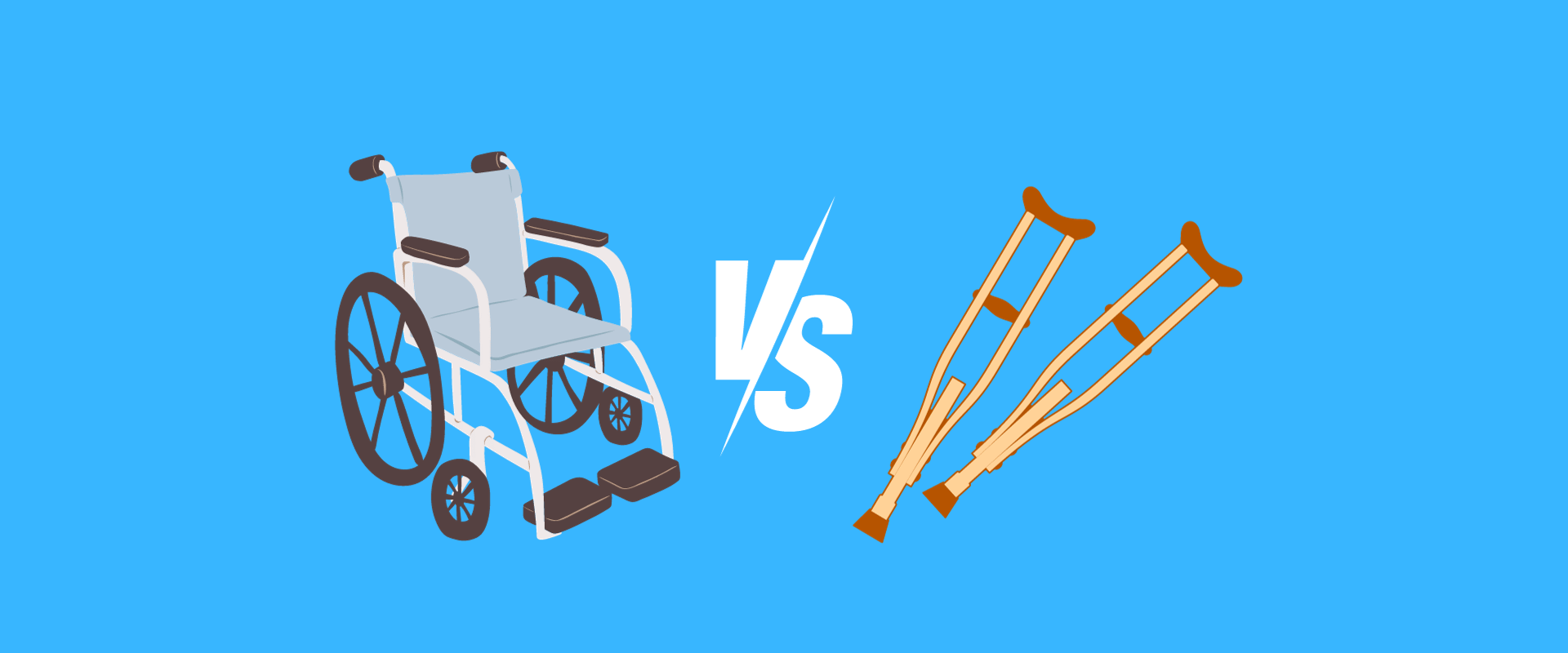Key Takeaways For Wheelchairs vs. Crutches
Wheelchairs: Seated Mobility: Provides seated solutions for those struggling to walk, ideal for significant mobility impairments. Comfort and Support: Offers a comfortable seated position with backrest and armrests, reducing physical strain. Indoor and Outdoor Use: Versatile for indoor and outdoor environments, suitable for various terrains.
Crutches: Mobility Assistance: These aid individuals with temporary injuries or mild to moderate mobility limitations by distributing weight off their legs. Operational Effort: These require upper body strength and coordination and are effective for users able to bear some leg weight. Temporary Aid: These are typically used during recovery and are not meant for long-term or continuous use like wheelchairs.
Considerations: User Condition: Wheelchairs are for severe or long-term impairments; crutches are for temporary limitations. Safety: Crutches may pose a falling risk for balance issues; wheelchairs offer excellent stability. Recovery Timeline: Crutches are suitable for temporary needs; wheelchairs are better for long-term or permanent mobility.
Top Wheelchairs
Top Crutches
Wheelchairs and crutches are essential mobility aids for individuals with limited mobility, but they serve different purposes and have distinct features. In this comparison, we’ll explore the differences between wheelchairs and crutches to help you make the right choice.
Wheelchairs
Mobility Assistance
Wheelchairs provide seated mobility solutions for individuals who struggle or cannot walk. They are typically used by people with significant mobility impairments or disabilities.
Comfort and Support
Wheelchairs offer a comfortable seated position with a backrest and armrests, providing crucial support and reducing physical strain on the user’s body.
Independence
Wheelchair users can achieve a high level of independence in their daily activities. They can move around without relying on the assistance of others.
Indoor and Outdoor Use
Wheelchairs are versatile and suitable for both indoor and outdoor use. There are models designed for various terrains, including rugged outdoor environments.
Storage and Transport
Wheelchairs can be bulkier and less portable compared to crutches. However, some models can be disassembled or folded to facilitate transportation.
User Control
Self-propelled manual wheelchairs allow users to move independently using their arm strength. Electric wheelchairs are controlled by a joystick or other input methods.
Crutches
Mobility Assistance
Crutches are walking aids to support individuals with temporary injuries or mild to moderate mobility limitations. They help distribute the weight off one or both legs while walking.
Operational Effort
Using crutches requires upper body strength and coordination. Users must be able to bear some weight on their legs to walk effectively with crutches.
Temporary Aid
Crutches are typically employed during recovery from injuries, surgeries, or conditions affecting the lower limbs. They are not meant for long-term or continuous use like wheelchairs.
Outdoor Use
Crutches are suitable for outdoor use, although they may require more effort and stability compared to indoor use.
Storage and Transport
Crutches are lightweight and highly portable, making them easy to transport and store when not in use.
User Control
Crutches require users to maintain balance and coordination while walking. They do not provide the same level of seated comfort and support as wheelchairs.
Considerations
User Condition
Choosing between a wheelchair and crutches depends on the individual’s specific condition and mobility needs. Wheelchairs are suitable for those with severe or long-term mobility impairments, while crutches are typically used for temporary mobility limitations.
Safety
Crutches may pose a risk of falling for individuals with balance issues and may not be suitable for those with certain medical conditions or older adults. Wheelchairs offer excellent stability.
Recovery Timeline
If the mobility limitation is expected to be temporary, crutches may be a more appropriate choice. Wheelchairs are better suited for long-term or permanent mobility needs.
Summary Of Wheelchairs Vs Crutches
In summary, the decision between a wheelchair and crutches should be based on the individual’s unique mobility limitations, the anticipated duration of assistance, and the level of support and comfort required during mobility. Consulting with healthcare professionals can help determine the most appropriate mobility aid for each person’s circumstances.
Top Wheelchairs
Top Crutches
Related Mobility Aid Comparison Articles
- Crutches vs. Walking Frames – Compare crutches and walking frames to determine which is better suited for your mobility needs.
- Best Crutches – Discover the top-rated crutches designed for comfort and support.
- Best Wheelchairs – Explore the best wheelchairs for comfort, mobility, and ease of use.
- Choosing the Right Mobility Aid – Learn how to select the best mobility aid for your condition and lifestyle.

















